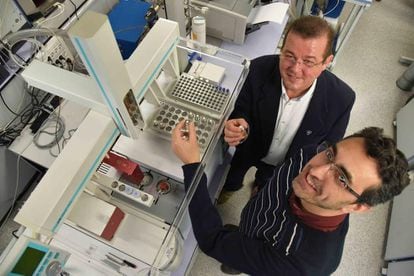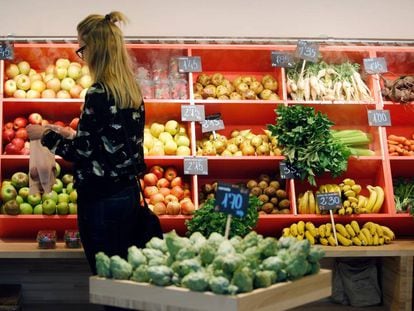Finding a solution for supermarket tomatoes that don’t taste like tomatoes
Scientists in Valencia are using a technique to cut and paste DNA in a bid to reclaim fruit’s flavor
An old saying in Spanish went: “Tomate con sal, jamón de pobres.,” which roughly translates as “Tomatoes with salt: ham for the poor,” and refers to the superb flavor offered by a simple dish for a rock-bottom cost. But perhaps it’s no surprise that the refrain has fallen out of use, given that supermarket tomatoes no longer taste like tomatoes. In 2014, 170 billion kilograms of tomatoes were produced around the world, according to the United Nations. And the truth is, most of them taste like cardboard.

“Producers get paid per kilo, not for the flavor,” says Antonio Granell, a researcher at the Institute of Molecular and Cell Biology of Plants in Valencia.
Granell is one of the planet’s foremost hopes for recovering the flavor and aroma of tomatoes. He is part of a team that has just finished sequencing the complete genome of 398 different varieties of the fruit. By examining all of them, the scientists identified the genetic code responsible for the 13 chemical compounds that give them their taste. These compounds are abundant in traditional varieties, but have nearly disappeared in their commercialized counterparts. The finding is so hopeful that it recently made the cover of Science magazine.
Not using this technique is like going to bingo instead of going to work Antonio Granell, Institute of Molecular and Cell Biology of Plants
“Now we have the tools to design the taste of the tomato à la carte,” explains Granell.
For decades, commercial producers have selected tomatoes based on their size, firmness and color – the main characteristics demanded by distributors. Along the way, tomatoes lost their taste.
“If, for example, you try to increase the sugar content, the tomatoes get smaller. And since the farmers are paid per kilo, the taste turns into an acceptable inconvenience,” says Granell.
He says there are two paths to bringing tasty tomatoes back to supermarkets. The longer route is through using genetic markers: scientists select plants with desirable characteristics (sweet, for example), which are drawn from crosses between different varieties, both traditional and modern. To accelerate the process, scientists are guided by the molecular markers associated with these characteristic, such as certain DNA fragments. If the markers are in the new plants, sweeter tomatoes will grow.

But Granell proposes a shorter path: the new and revolutionary CRISPR – Clustered Regularly Interspaced Short Palindromic Repeats – technology, which is able to simply and quickly cut and paste multiple DNA sequences.
“With CRISPR you can change just one letter of the billion letters in a tomato’s genome. And it’s not making genetically modified fruit. It’s not putting the genes from cockroaches into tomatoes. The final product is 100% tomato,” he says. “There is one letter less, that could have disappeared because of a spontaneous mutation, which is how nearly all varieties of citrus fruits have formed.”
Granell has already eaten his share of CRISPR modified tomatoes. His laboratory is a pioneer in using this technology on the fruit.
“With traditional methods of vegetable improvement we rely on chance, which is where the desirable mutations come from. With CRISPR we know what we are doing. Not using this technique is like playing bingo instead of going to work,” he adds.
To date, the European Commission has not clarified the legal status of organisms produced by CRISPR.
Now we have the tools to design the taste of the tomato à la carte Antonio Granell
Lluis Montoliu, researcher at the National Biotechnology Center of Spain, applauds Granell’s proposal.
“CRISPR allows scientists to modify the genome with efficiency and ease, obtaining similar mutations, that are sometimes even indistinguishable from what happens in the natural world in different wild varieties,” says Montoliu.
“There are precedents. In the United States they have already approved mushrooms that have a harder time spoiling due to the deactivation of certain oxidants that are involved in the process. In other words, it hasn’t gotten in the way of their commercialization because it doesn’t represent any kind of additional risk for consumers, given that it isn’t considered a genetic modification.”
Montoliu is a member of the Panel of Ethics at the European Research Council, in charge of reviewing projects that the council could potentially finance. In Sweden, he notes, the plant varieties that come from CRISPR “are not considered genetically modified organisms. Instead they are mutants, obtained in a different way, but mutants nevertheless, just like so many other natural varieties.”

The European Group on Ethics in Science and New Technologies, an advisory body for the European Commission, published a report about genetic editing in 2016. It requested more studies on the subject before taking an official stance.
On January 18, two days before Trump became president, the US Food and Drug Administration (FDA) presented draft regulations that declared that all animals whose genomes were edited will have to be examined for safety and efficacy in an approval process similar to that of new medications.
“It’s clear that it’s an unstoppable revolution in biotechnology and it can be extraordinarily beneficial for society,” says Montoliu. “We shouldn’t go back to prohibition simply because of a poorly understood precautionary measure, an endless loop that wants to keep something banned while at the same time there is no evidence that it is harmful, which could reduce it to absurdity.”
“If negative data aren’t expected, don’t exist, or are unable to be found in the tomatoes or in the humans who consume them, the fact that they are trying to impede the consumption of tomatoes edited with CRISPR, which at the most will improve the taste, makes me think – please, let’s not waste our time and let us enjoy an exquisite tomato salad,” he says.
English version by Alyssa McMurtry.













































